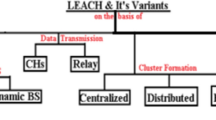Abstract
In the paper the adaptability of Dynamic Source Routing (DSR) Protocol to the changes in network topography, its ability to establish new routes and the viability in modern sensing devices is simulated and analyzed. For a dynamic network the distance between source and destination changes along with their position in respect to their neighboring nodes. In our experiments, three scenarios considering real world deployment techniques like fixed position, clustering and random mobility are designed and the behavior of the protocol has been studied in two networks consisting of 100 and 150 nodes respectively. Comparative analysis is performed considering characteristics such as Instantaneous throughput, Bandwidth consumption, Average throughput, Packet delivery ratios and Residual energy of the individual nodes and of the network. The experimental data provides valuable insight for real-world applications. Path selection in DSR protocol is based on control messages which are flooded throughout the network. As seen from our experiments, the protocol can be greatly enhanced by reducing the overhead (number of packets required for network communication) to conserve bandwidth. Before making changes to the header or the routing mechanism we need to make sure that the protocol can still accommodate the various types of payloads, options and adopt to fragmented or dynamic networks. Due to the severe limitations on the resources available, the selected protocol should provide high energy efficiency, reliability and robustness to attacks. Hence the analysis of networking/routing protocols should be considered and variations of the selected protocol can be developed to accommodate the challenges faced in such networks.






Similar content being viewed by others
Data availability
The datasets generated during and/or analysed during the current study are available from the corresponding author on reasonable request.
References
Dione D, Mbainaissem TC, Ndekou PP (2022) Optimizing lifetime of a wireless sensor network covering moving targets. SN Appl Sci 4:192. https://doi.org/10.1007/s42452-022-05073-1
Dynamic Wireless Sensor Networks - New Directions for Smart Technologies (n.d.) https://doi.org/10.1007/978-3-319-92807-4
Goswami P, Mukherjee A, Hazra R, Yang L, Ghosh U, Qi Y, Wang H (2022) AI based energy efficient routing protocol for intelligent transportation system. IEEE Trans Intell Transport Syst 23(2):1670–1679. https://doi.org/10.1109/TITS.2021.3107527
Issariyaku T, Hossain E (2008) “Linkage between OTcl and C++ in NS2” first online: 20
Issariyaku T, Hossain E (2008) Introduction to network simulator NS2. Springer, Berlin
Kandris D, Nakas C, Vomvas D, Koulouras G (2020) Applications of wireless sensor networks: an up-to-date survey. Appl Syst Innov 3:14. https://doi.org/10.3390/asi3010014
Kong R (2008) The simulation for network mobility based on NS2. In: 2008 International Conference on Computer Science and Software Engineering, vol 4, pp 1070–1074
Li K (2022) Application of Artificial Intelligence System Based on Wireless Sensor Network in Enterprise Management. Comput Intell Neurosci 2022(2169521):10. https://doi.org/10.1155/2022/2169521
Luo Y, Wang J, Chen S (2006) An energy-efficient DSR routing protocol based on mobility prediction, 2006 International Symposium on a World of Wireless, Mobile and Multimedia Networks (WoWMoM'06), Buffalo-Niagara Falls, NY, pp 3-446
Overview of Proactive Routing Protocols in MANET (n.d.) Conference: 2014 International Conference on Communication Systems and Network Technologies (CSNT). https://doi.org/10.1109/CSNT.2014.42
Propagation models for wireless communication systems (2018) Int J Eng Technol (IRJET) Volume: 05 Issue: 01
Rajasoundaran S, Prabu AV, Routray S, Malla PP, Kumar GS, Mukherjee A, Qi Y (2022) Secure routing with multi-watchdog construction using deep particle convolutional model for IoT based 5G wireless sensor networks. Comput Commun 187:71–82. https://doi.org/10.1016/j.comcom.2022.02.004
Sabor N, Sasaki S, Abo-Zahhad M, Ahmed SM (2017) A Comprehensive Survey on Hierarchical-Based Routing Protocols for Mobile Wireless Sensor Networks: Review, Taxonomy, and Future Directions. Wirel Commun Mob Comput 2017(2818542):23. https://doi.org/10.1155/2017/2818542
Shahraki A, Taherkordi A, Haugen Ø, Eliassen F (2020) Clustering objectives in wireless sensor networks: A survey and research direction analysis. Comput Netw 180:107376, ISSN 1389-1286. https://doi.org/10.1016/j.comnet.2020.107376
Verma AK, Sadawarti H (2010) Performance analysis of AODV, DSR and TORA routing protocols. IACSIT 2(2) ISSN: 1793–8236:226–231
Wireless Sensor Networks - Energy Harvesting and Management for Research and Industry (n.d.) https://doi.org/10.1007/978-3-030-29700-8
Funding
No funding was received to assist with the preparation of this manuscript.
Author information
Authors and Affiliations
Corresponding author
Ethics declarations
Conflicts of interests/competing interests
authors have no conflicts of interest/Competing interests to declare that are relevant to the content of this article.
Financial interests
The authors have no conflicts of interest to declare that are relevant to the content of this article.
Additional information
Publisher’s note
Springer Nature remains neutral with regard to jurisdictional claims in published maps and institutional affiliations.
Rights and permissions
Springer Nature or its licensor (e.g. a society or other partner) holds exclusive rights to this article under a publishing agreement with the author(s) or other rightsholder(s); author self-archiving of the accepted manuscript version of this article is solely governed by the terms of such publishing agreement and applicable law.
About this article
Cite this article
Rakheja, R., Khera, S., Turk, N. et al. Parametric analysis of dynamic routing protocol for wireless sensor networks. Multimed Tools Appl 82, 39035–39055 (2023). https://doi.org/10.1007/s11042-023-15076-8
Received:
Revised:
Accepted:
Published:
Issue Date:
DOI: https://doi.org/10.1007/s11042-023-15076-8




